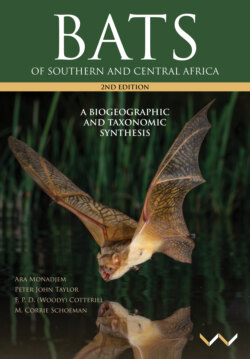Читать книгу Bats of Southern and Central Africa - Ara Monadjem - Страница 20
На сайте Литреса книга снята с продажи.
MIGRATION
ОглавлениеIn temperate (and some subtropical) regions, cold winters force bats to migrate or hibernate. A few species migrate over longer distances (> 500 km), while many make short, local (< 50 km) or medium distance (< 500 km) movements between winter and summer roosts (Fleming and Eby 2003). In southern Africa, the seasonal appearances and disappearances of Eidolon helvum likely reflect responses of these bats to changing food supplies (Richter and Cumming 2008).
In Gauteng, Limpopo and the Western Cape (South Africa), Miniopterus natalensis migrates up to 260 km (van der Merwe 1973a, 1975) between warmer maternity caves where females give birth in summer (e.g. the De Hoop Guano Cave in the Western Cape, and several caves in the lowveld of Limpopo), and colder caves in winter, where mating and hibernation occur (e.g. several caves in the interior of the Western Cape, and on the Highveld of Gauteng). Myotis tricolor undertakes similar seasonal migrations, although the details are not yet known.
Rousettus aegyptiacus may also make migrations of hundreds of kilometres. An individual tattooed at caves in the Tzaneen area of Limpopo was subsequently recovered at Mtunzini on the northern coast of KwaZulu-Natal (Jacobsen and du Plessis 1976). Population numbers of the Mpumalanga colonies decrease during winter and increase again in summer, while, conversely, a known colony at Mission Rocks Bat Cave (Greater St Lucia Wetland Park) on the northern coast of KwaZulu-Natal decreases in size dramatically (from > 5,000 to < 300) at the beginning of spring, and increases again during winter. It seems highly likely that the same bats migrate from winter roosts on the warm KwaZulu-Natal coast to summer roosts in the Limpopo lowveld.
